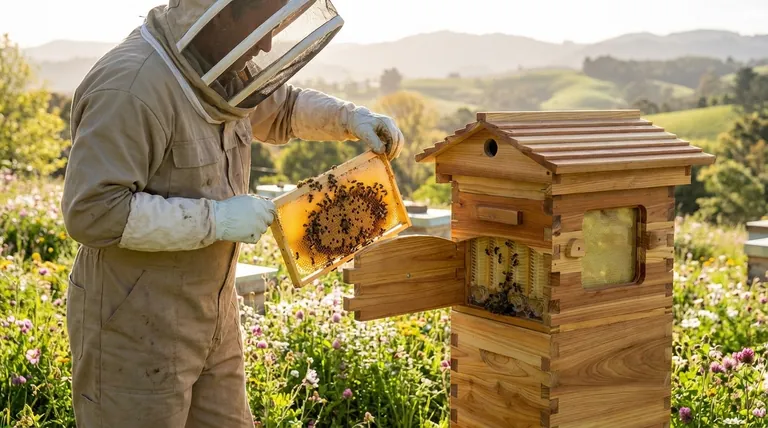Monitoring colony size at specific times of the year is crucial for proactive hive management. It allows a beekeeper to anticipate the colony's needs and intervene effectively to prevent catastrophic events like swarming or winter starvation, ensuring the hive remains healthy and productive.
The core purpose of seasonal monitoring is not just to count bees, but to understand the colony's trajectory. It’s about ensuring the hive has the right population and resources at the right time to meet the challenges of the coming season.

The Spring Buildup: Managing Explosive Growth
Spring is the most dynamic period in the beekeeping calendar. The queen begins laying thousands of eggs per day, leading to an exponential increase in population.
Assessing Population Growth
After the relative quiet of winter, your first spring inspections are vital. You need to see a rapidly expanding brood pattern, which indicates a healthy, productive queen is preparing the workforce for the season ahead.
A slow or patchy buildup can be an early warning sign of a failing queen, disease, or insufficient pollen stores.
Preventing Swarming
As the colony becomes crowded, its natural instinct is to swarm—the queen leaves with half the bees to find a new home. Monitoring allows you to spot the signs, such as the creation of queen cups or swarm cells.
By identifying these signals early, you can take action, such as splitting the hive, to prevent the loss of half your workforce and your queen.
Managing Space
A rapidly growing colony can quickly run out of room. This congestion is a primary trigger for swarming.
Monitoring population size tells you precisely when to add more boxes (supers) for honey storage or another brood box for the queen to lay in. Providing space just before it's needed keeps the bees focused on work, not swarming.
Summer and Autumn: From Peak Strength to Winter Readiness
While spring is about managing growth, summer and autumn are about sustaining that strength and then preparing for the decline.
Sustaining the Workforce
During the main nectar flow in summer, a large population is essential for maximizing honey production. Monitoring ensures the colony maintains its strength and doesn't suffer a "brood break" where the queen stops laying due to a lack of space.
Assessing Winter Stores
As autumn approaches, the focus shifts entirely to survival. You must assess the colony's size and, more importantly, its honey stores.
A small population cluster has a harder time generating heat, and insufficient honey is a death sentence. Monitoring tells you if you need to combine weak colonies or provide supplemental feeding.
The Critical Risks of Poor Timing
Monitoring isn't just about what you do; it's about what you don't do. Both over-inspection and under-inspection carry significant risks.
The Danger of Under-Inspection
Failing to monitor frequently enough during the spring buildup is a common mistake. You can easily miss the signs of swarm preparation, and a hive can go from strong to swarmed in less than two weeks.
In the autumn, failing to assess winter stores can lead directly to colony starvation and death over the winter.
The Danger of Over-Inspection
While necessary, every inspection disrupts the hive. Opening the brood box too often can stress the colony, chill the developing brood, and increase the risk of accidentally injuring or killing the queen.
The goal is to be methodical and efficient, gathering the necessary information with minimal disturbance.
Matching Your Monitoring to Your Goal
Your approach to monitoring should align with your specific objectives as a beekeeper.
- If your primary focus is honey production: Pay closest attention to colony size just before and during the main nectar flow to ensure you have a massive workforce ready to forage.
- If your primary focus is colony survival and health: Your most critical inspections are in early spring to confirm the queen is laying well and in autumn to verify sufficient winter food stores.
- If your primary focus is increasing your number of colonies: Monitor vigilantly in mid-spring for swarm cells, which are your primary cue for when to make a split.
Ultimately, seasonal monitoring transforms you from a reactive keeper into a proactive partner with your bees.
Summary Table:
| Season | Primary Goal | Key Action |
|---|---|---|
| Spring | Manage explosive growth | Prevent swarming by adding space; assess queen health. |
| Summer | Sustain peak workforce | Ensure strong population for maximum honey production. |
| Autumn | Prepare for winter | Assess colony size and food stores for winter survival. |
Equip your apiary for success with HONESTBEE.
Proactive hive management requires the right tools. As a trusted supplier for commercial apiaries and beekeeping equipment distributors, HONESTBEE provides the durable, high-quality supplies you need—from hive boxes and feeders to protective gear—to monitor your colonies effectively and maximize their health and productivity.
Let's build a stronger operation together. Contact our wholesale team today to discuss your equipment needs.
Visual Guide

Related Products
- Automatic Honey Flow Beehive 4 Frame Mini Hive for Beekeeping
- Honey Flow Garden Bee Hive Flow Hive Best Beehive for Beginners
- Wholesales Dadant Size Wooden Bee Hives for Beekeeping
- Langstroth Bee Hives Bee Keeping Box for Beginners Beekeeping
- Long Langstroth Style Horizontal Top Bar Hive for Wholesale
People Also Ask
- What is the selling point of the Flow Hive? A Revolutionary, Stress-Free Honey Harvest
- How does the Flow Hive simplify honey harvesting? The Revolutionary 'Honey on Tap' System Explained
- What are the advantages of using a Flow Hive? Simplifying Harvesting for Modern Beekeepers
- What are the benefits of using the Flow Hive for honey harvesting? Simplify Your Harvest & Protect Your Bees
- How does the Flow Hive improve bee health? By Minimizing Stress During Honey Harvest



















